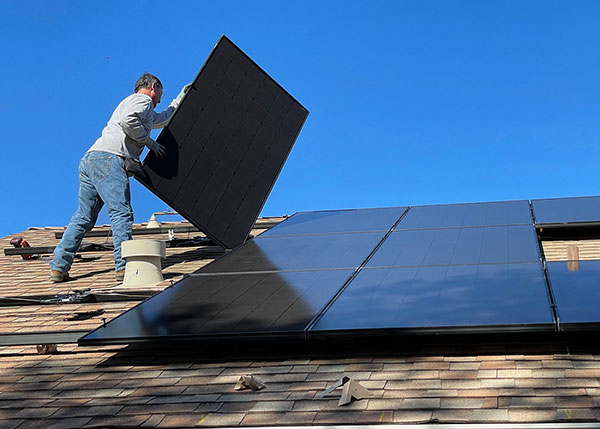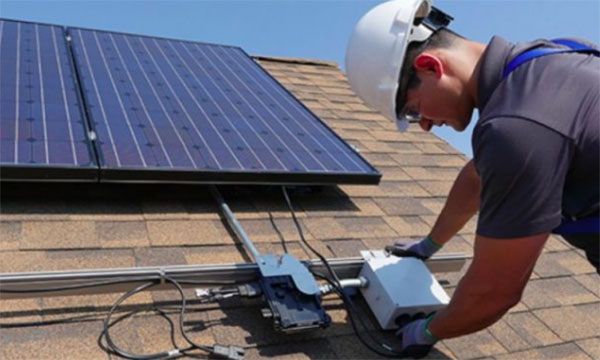Description
A solar panel converts sunlight into electricity, while an inverter changes this electricity from direct to alternating current.
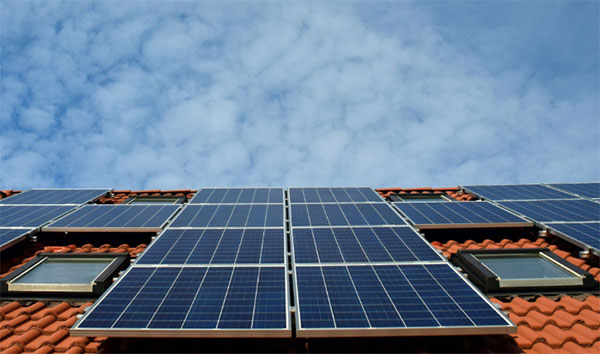
Understanding Solar Panels
Solar panels, also known as photovoltaic (PV) panels, transform sunlight into electricity. They consist of many solar cells made from materials like silicon, which is effective in converting sunlight to electrical energy.
Basic Function and Composition
Solar panels operate on the principle of the photovoltaic effect. When sunlight hits the solar cells, it causes electrons to move, creating a flow of electric current. Each solar cell contains a semiconductor, typically silicon, layered with conductive materials. These layers establish an electric field, crucial for electricity generation.
Types of Solar Panels
There are mainly three types of solar panels:
- Monocrystalline Solar Panels: Made from a single silicon crystal, these panels are known for high efficiency and sleek design. They typically offer efficiencies around 15-20%.
- Polycrystalline Solar Panels: Constructed from multiple silicon crystals, these are slightly less efficient than monocrystalline panels, usually around 13-16%, but often come at a lower cost.
- Thin-Film Solar Panels: These panels use materials like amorphous silicon or cadmium telluride. They offer a different aesthetic and are more flexible, but their efficiency, ranging from 10-13%, is generally lower compared to crystalline silicon panels.
Role in Solar Power Systems
Solar panels serve as the primary component in solar power systems, capturing sunlight to generate electricity. Their role is crucial in determining the overall efficiency and power output of the system. The size and number of panels needed depend on the energy requirements and available space. For instance, a residential setup might need a system ranging from 5 kW to 10 kW, requiring about 15-40 solar panels based on their efficiency and size. In terms of lifespan, solar panels typically last between 25 to 30 years, maintaining over 80% of their efficiency towards the end of their lifespan.
The integration of solar panels into power systems also involves considering factors like the orientation and angle of installation, which significantly affect their energy harvesting capability. For optimal performance, panels are usually installed facing south in the Northern Hemisphere, at an angle that equals the latitude of their location.
Solar panels have seen a significant reduction in cost over the years. As of my last update, the average cost of solar panels ranged from $2.50 to $3.50 per watt, making the total cost for a typical residential solar system between $15,000 and $25,000 before tax credits or incentives. This investment is often recovered over time through savings in electricity bills and potential incentives from governments or local utilities
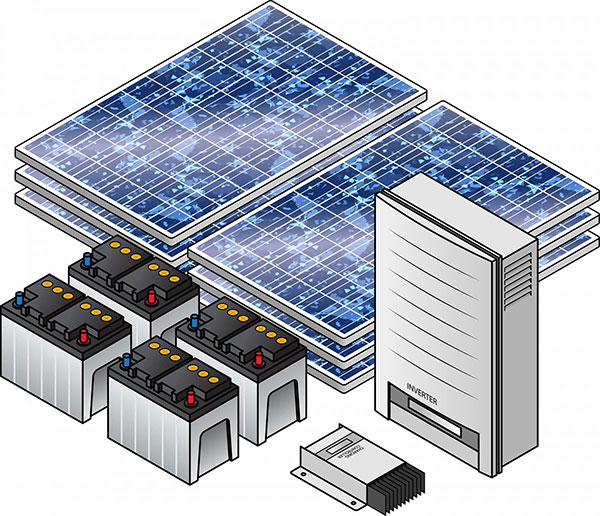
Exploring Solar Inverters
Solar inverters play a pivotal role in solar power systems, converting the direct current (DC) electricity generated by solar panels into alternating current (AC) electricity, which is the standard form used in homes and businesses.
Primary Function of Solar Inverters
The primary function of a solar inverter is to invert the DC output of solar panels into AC. This conversion is crucial because most home appliances and the grid operate on AC. Moreover, the efficiency of an inverter affects the overall system performance. Modern solar inverters typically achieve an efficiency rate of 95-98%, ensuring minimal energy loss during conversion.
Varieties of Solar Inverters
Solar inverters come in various forms, each suited to different solar power systems:
- String Inverters: These are the most common type, ideal for systems where solar panels are installed in a single plane. They connect a string of panels to the inverter. Their power capacity usually ranges from 3 kW to 10 kW, suitable for residential or small commercial systems.
- Microinverters: Installed on individual solar panels, they maximize the output of each panel, especially useful in systems where shading or panel orientation varies. While more expensive, they offer better efficiency and panel-level monitoring.
- Central Inverters: Used primarily in large solar farms, they handle higher power capacities, often exceeding 100 kW. They are cost-effective for large-scale operations but not suitable for residential use.
- Hybrid Inverters: Combining a solar inverter with a battery inverter, they allow energy storage in a battery system for later use. This type is increasingly popular in residential systems for energy independence.
Integration with Solar Power Systems
Integrating an inverter into a solar power system requires careful consideration of the system's size, layout, and intended use. The inverter must match the system's total power output and accommodate any future expansions. For instance, a residential system with a total power capacity of 5 kW would require an inverter that can handle at least this amount, preferably with a small margin for added efficiency.
Comparative Analysis
Comparing solar panels and solar inverters is essential to understand their unique roles in a solar power system. Here's a detailed comparative analysis focusing on their functions, energy conversion processes, and efficiency metrics.
Differences in Function
| Solar Panels |
Solar Inverters |
| Convert sunlight into direct current (DC) electricity. |
Convert DC electricity from solar panels into alternating current (AC). |
| Capture solar energy using photovoltaic cells. |
Enable the use of solar energy in homes and businesses by adapting the current type. |
| Primary source of power generation in a solar system. |
Act as a gateway for solar power to be utilized effectively. |
Energy Conversion Processes
| Solar Panels |
Solar Inverters |
| Use the photovoltaic effect to generate electricity. |
Use electronic circuits to invert current. |
| Efficiency depends on panel type and sunlight exposure. |
Efficiency depends on inverter type and power conversion process. |
| Typically have an efficiency rate of 15-20% for monocrystalline and 13-16% for polycrystalline. |
Modern inverters achieve an efficiency rate of 95-98%. |
Efficiency and Performance Metrics
| Aspect |
Solar Panels |
Solar Inverters |
| Efficiency |
Varies by type: 15-20% for monocrystalline, 13-16% for polycrystalline. |
Typically 95-98%, key for minimizing energy loss during conversion. |
| Lifespan |
Around 25-30 years, maintaining over 80% efficiency towards the end. |
Shorter lifespan of 10-15 years, often requires replacement. |
| Cost |
Average cost ranges from $2.50 to $3.50 per watt. |
String inverters: $1,000-$2,000; Microinverters: $150-$250 per panel. |
| Power Capacity |
Depends on system size, typically 5 kW to 10 kW for residential setups. |
Should match or exceed the total power output of the solar panels. |
| Environmental Impact |
Significant reduction in carbon footprint by using renewable energy. |
Enhances the effectiveness of solar panels in reducing carbon footprint. |
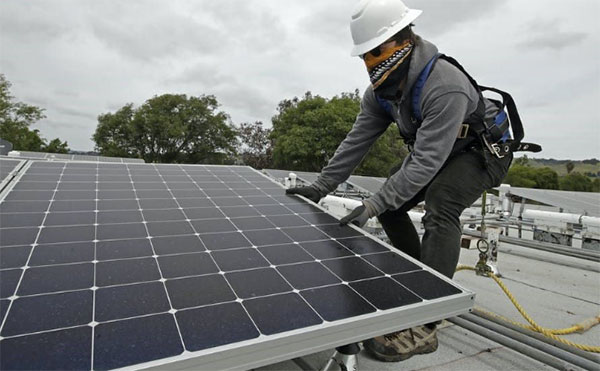
Installation and Maintenance Considerations
When integrating solar panels and inverters into a solar power system, understanding their installation and maintenance requirements is crucial for optimal performance and longevity.
Installing Solar Panels vs. Solar Inverters
Solar Panels:
- Installation requires careful planning, including assessing roof strength, orientation, and shading.
- Professional installation is recommended to ensure safety and efficiency.
- The cost of installation varies depending on system size and complexity. For a residential system, installation costs can range from $15,000 to $25,000.
- Solar panels need to be mounted at an optimal angle for maximum sunlight exposure, often facing south in the Northern Hemisphere.
Solar Inverters:
Inverter installation should align with the power output of the solar panels.
It's important to place inverters in a cool, shaded location to prevent overheating.
The installation cost of an inverter is usually included in the overall solar system installation cost.
Easy accessibility for maintenance and monitoring is a key consideration in inverter placement.
Maintenance Requirements and Lifespan
Solar Panels:
Require minimal maintenance, mostly cleaning to remove dust and debris.
Lifespan of 25-30 years with maintained efficiency.
Regular inspections can help detect and rectify any physical damages or efficiency issues.
Solar Inverters:
- Require more frequent maintenance than solar panels.
- Generally have a shorter lifespan of 10-15 years.
- Maintenance includes checking for software updates, ensuring proper ventilation, and periodic inspections for wear and tear.
Compatibility and System Integration Issues
- Compatibility: It's essential to ensure that the inverter's capacity matches the solar panel system’s power output. Mismatched components can lead to inefficiencies or damage.
- System Integration: Integration with existing electrical systems and the grid must comply with local regulations and safety standards.
- Monitoring Systems: Modern solar systems often include monitoring systems, which require proper integration with both panels and inverters for accurate performance data.
- Battery Storage: If the system includes battery storage, additional considerations for compatibility and integration with both the panels and inverter are necessary.
Economic and Environmental Impact
The transition to solar energy not only affects the economy but also has a significant impact on the environment. Understanding the cost analysis of solar panels versus inverters and their environmental benefits is crucial.
Cost Analysis of Panels vs. Inverters
Solar Panels:
- The cost primarily depends on the type and size of the panel. Monocrystalline panels, known for higher efficiency, range between $1 to $1.50 per watt, leading to a total cost of $6,000 to $9,000 for a 6 kW system.
- Installation costs add to this, bringing the total expense for a standard residential solar system to approximately $15,000 to $25,000.
Solar Inverters:
The cost varies depending on the type. A string inverter for a residential system might cost between $1,000 and $2,000.
Microinverters cost more, typically around $150 to $250 per panel, adding up to $2,250 to $3,750 for a 15-panel system.
Over time, the need to replace inverters, which have a shorter lifespan than panels, should be factored into the overall budget.
Environmental Benefits and Sustainability
Reduced Carbon Footprint: Solar panels significantly reduce greenhouse gas emissions. A residential solar system can offset approximately 5 tons of carbon dioxide per year, which is equivalent to planting over 100 trees annually.
Sustainable Energy Source: Solar power is a renewable resource, unlike fossil fuels. This sustainability aspect is crucial in combatting climate change and reducing dependence on non-renewable resources.
Decreased Air Pollution: By reducing reliance on fossil fuel-powered electricity generation, solar panels contribute to a decrease in air pollutants like sulfur dioxide and particulate matter, which are harmful to health.
Energy Independence: Solar energy offers a path to energy independence, reducing reliance on imported fuels and contributing to national energy security.
Promoting Biodiversity: Solar farms, when properly planned, can coexist with local flora and fauna, promoting biodiversity.





